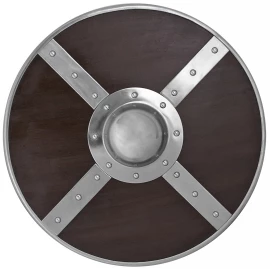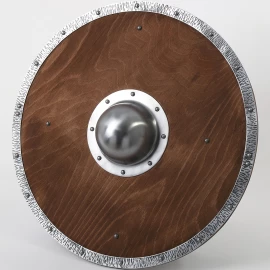Viking shields
The viking shield was the most common means of defense. Traditionally shields were made of linden (Lime) wood although other timbers may also have been used such as Alder and Poplar. These timbers are not very dense and are light in the hand. They also have a characteristic in that they are not inclined to split unlike Oak. Also, the fibers of the timber bind around blades preventing the blade from cutting any deeper unless a lot more pressure is applied. Round shields seem to have varied in size from around 45 - 120cm (18" - 48") in diameter but the smaller and more manageable 75 - 90cm (30" - 36") is by far the most common.
Filter products
Viking shield
The smaller viking shield sizes come from the pagan period for the Saxons and the larger sizes from the 10th and 11th centuries. By the beginning of the eleventh century the bottom edge of the viking shield evolved downwards to cover the upper leg giving rise the kite shield. There is evidence for both flat and curved kite shields, with the curved being most likely, and most having bosses. It is debatable whether or not these bosses were used in the same fashion as round shields; i.e. centre gripped. The tendency in re-enactment is to wear them crossbraced, as if you were still riding. This is because if the shield is held near the boss, the lower section acts like a pendulum making it difficult to operate. Most viking shields are shown in illuminations as being painted a single colour although some have a design painted onto them; the commonest designs are simple crosses or derivations of sun wheels or segments. The few round shields that survived have much more complicated designs painted on them and sometimes very ornate silver and gold work applied around the boss and the strap anchors.












